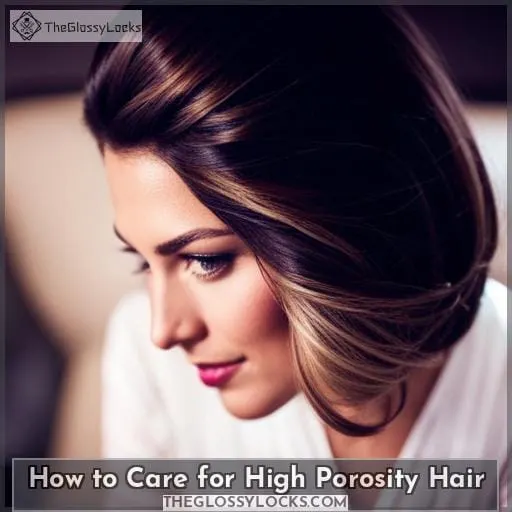This site is supported by our readers. We may earn a commission, at no cost to you, if you purchase through links.
 Are you struggling with dry, brittle hair? If so, your locks may be exhibiting signs of high porosity. High porosity is a hair type that has wide-open cuticles and absorbs moisture quickly but can also easily lose it just as fast.
Are you struggling with dry, brittle hair? If so, your locks may be exhibiting signs of high porosity. High porosity is a hair type that has wide-open cuticles and absorbs moisture quickly but can also easily lose it just as fast.
This makes it difficult to keep the strands hydrated and results in frizziness or damage when not properly cared for.
Table Of Contents
Key Takeaways
- High porosity hair has open cuticles, leading to frizz, dryness, and breakage.
- Causes of high porosity include genetics, UV exposure, heat damage, and chemical treatments.
- Care for high porosity hair involves using moisture-rich products, avoiding sulfates and alcohol, and limiting heat styling.
- Other tips include sleeping on satin pillowcases, getting regular trims, and using detanglers and heat protectants.
What is High Porosity Hair?
Are you interested in learning more about high porosity hair? High porosity hair is characterized by frizz, dullness, tangles, breakage, and dryness due to an open cuticle layer. Causes of high porosity can include genetics, UV exposure, heat damage, and chemical treatments.
Characteristics of High Porosity Hair
You may experience dryness, frizziness, tangles, and quick air drying with your unmanageable locks due to the openness of the cuticle layer. High porosity hair absorbs moisture quickly but loses it just as fast. To keep your hair healthy and hydrated, you need a specific hair care routine: use heavier products like oils or butters; avoid sulfates and high alcohol content products; minimize heat styling with protectants; rinse in lukewarm water for best results.
You should also sleep on satin pillowcases to retain moisture and prevent breakage from occurring overnight.
Causes of High Porosity Hair
Factors like genetics, UV exposure, heat styling, and chemical treatments can all contribute to the porosity of your locks. Genetics determine how close or far apart a person’s cuticles are, which will directly affect their hair’s ability to retain moisture.
Environmental factors, such as sun exposure, can weaken hair fibers, making them more porous and vulnerable to breakage. Hair treatments like bleaching and straightening damage the protective barrier of a strand, leading it down the path towards high porosity over time.
Heat damage from blow-drying or curling also affects this delicate balance by damaging cuticle cells, allowing for easy absorption but difficulty in retaining moisture. This can result in dryness, frizziness, tangles, and breakage due to humidity levels.
How to Determine Your Hair Porosity
Discovering your hair porosity is key to understanding how best to care for it and maintain its health. A simple DIY Hair Porosity Test can help you determine if your hair is low, medium, or high porosity.
To do the test, take a single strand of shed hair and drop it into a cup of water. If the strand floats on top, this indicates low porosity. If the strand slowly sinks down, this means medium porosity.
Caring for high-porosity locks requires extra TLC. This includes using moisture-rich products with hydrating labels, limiting shampooing to once or twice a week only, and avoiding sulfates and alcohol-based products.
It’s also important to avoid heat styling tools and tight hairstyles to reduce the risk of breakage while maintaining softness and shine.
Furthermore, consider trying deep conditioning masks at least once every two weeks. Use leave-in conditioners and protective oils to combat frizziness. Don’t forget to increase hydration levels through the LOC method (Liquid – Oil – Cream).
Finally, be patient since restoring a healthy look takes time. Combine regular trimming sessions every 4–6 weeks, depending on individual needs, to maintain the health of your hair.
How to Care for High Porosity Hair
Caring for high porosity hair is essential to maintaining its health and vibrancy. Getting regular trims every 4-6 weeks, shampooing only once or twice a week, choosing the right moisturizing shampoos and conditioners with hydrating ingredients, using a detangler to prevent breakage when brushing – all of these steps are key in caring for this type of hair.
Getting Regular Trims
Getting regular trims every 4-6 weeks is like giving your hair a fresh start, helping to prevent split ends and keep it healthy and hydrated.
A trim can benefit high porosity hair by removing breakage, allowing for better product absorption and locking in moisture.
Consult with a stylist on the best haircut frequency for you. They may even recommend certain products or techniques that could be beneficial to help fix any damage caused by high porosity hair – such as using heat protectants when styling or avoiding tight hairstyles that pull on strands of your delicate locks!
With patience in practicing proper care tips, you’ll soon see healthier ends growing out from within!
Shampooing Frequency
Limit your shampooing to once or twice a week, and be sure to follow it up with a deeply hydrating conditioner for best results. Using sulfate-free products will help reduce dryness and breakage in high porosity hair.
Detangling techniques, such as using a wide-tooth comb, should also be employed after washing to prevent further damage from occurring due to over brushing.
Heat protection is essential when styling, so use a heat protectant spray before blow drying or using a curling iron for optimal results.
It’s also important to not only fight frizz but also humidity in general by using anti-humidity sprays. This helps keep the cuticle layer closed off and prevents moisture loss throughout the day.
Hair porosity testing can easily be done at home if you’re uncertain of your level of porosity. Simply drop strands of shed hair into water: floating (low), slow sinking (medium), instant sinking (high).
Choosing the Right Shampoo
When choosing the right shampoo for your high porosity hair, look for ones that are specifically designed to hydrate and nourish while avoiding harsh sulfates and parabens.
Look out for ingredients like oils, shea butter, keratin protein, liquid silk, or ceramides in a product’s list of ingredients.
Consider cleansing methods such as co-washing with conditioner only or using gentler shampoos without stripping away natural oils from your scalp.
Choose hydrating products that will help retain moisture in high porosity hair by sealing cuticle gaps and protecting against heat damage.
Avoid over-washing, which can lead to dryness; limit it to once or twice a week at most!
Importance of Using Conditioner
Using a conditioner is essential for keeping high porosity hair hydrated and healthy, so don’t skip out on this step in your routine. Select a conditioner specifically designed to lock in moisture with hydrating ingredients like oils and butters.
For deep conditioning, use masks such as SheaMoisture High Porosity Moisture Correct Masque or Marc Anthony Grow Long Anti-Breakage Hair Mask. Apply the product by sectioning off hair and evenly distributing from root to tip before rinsing thoroughly after 5 minutes of processing time.
Conditioners are also beneficial for detangling purposes; make sure not to pull too hard while brushing through knots! With regular use of quality conditioners tailored towards high porosity needs, you’ll have softer strands that look healthier than ever!
Using a Detangler
To prevent breakage and keep your hair healthy, run a detangler through it before brushing. However, avoid tugging too hard at tangled strands as this could cause more damage than good.
Benefits of using a detangler include reduced styling time, improved manageability, and softness of the hair, and fewer split ends and breakage due to fewer knots in the hair shafts.
When applying a detangler, use an adequate amount so that it spreads evenly throughout your locks without weighing them down or making them greasy. For best results, look for products specifically formulated for high porosity or damaged hair, such as SheaMoisture High Porosity Moisture Correct Masque or Olaplex No 4 Bond Maintenance Shampoo & Conditioner Duo Pack.
These products will nourish each strand from root to tip while providing heat protection during styling sessions.
The benefits of using conditioners instead are mainly seen on finer textures. Those with coarser high porosity curls should use both!
Always finish off by rinsing with cold water to seal cuticle gaps, aiding hydration retention over time – perfect for those frizzy days!
Avoiding Tight Styles
Tight hairstyles can cause further damage to your already porous strands, so opt for gentle styles like loose braids or buns. Braid-outs and twist-outs are great heat-free options that will promote hair elasticity while providing frizz control.
Protective hairstyles, such as wigs and weaves done by a stylist, offer an additional layer of protection against overprocessing your high porosity hair from tight styles. Additionally, it is recommended to have a consultation with a licensed professional if you’re unsure about the impact of different styling techniques on your specific hair type.
Be sure to use soft bands when tying up any style, avoiding metal clips that can lead to breakage due to their weighty nature!
Trying Hair Treatments
Give your high porosity hair a break with nourishing treatments like deep conditioning masks and hot oil therapy; they may be just what the doctor ordered! Hair masks are great for repairing damage. Detangling tips can help you manage without causing further harm. Frizz control products can help tame flyaways and keep moisture locked in.
Hot oil therapies are also effective at restoring strength and shine, so give them a try if you’re looking for an extra boost of hydration.
Managing Frizz
Combat frizz with anti-frizz products like protective oils for lasting hydration and manageability. Opt for lightweight formulas that won’t weigh hair down or make it greasy. Use a leave-in conditioner to protect against humidity.
Look out for ingredients like almond oil, argan oil, jojoba oil, coconut extract, and shea butter, which all help reduce frizz.
For extra protection against heat styling tools, use a thermal protecting spray or serum before blow-drying or straightening your hair. Tight hairstyles can also lead to increased levels of frizz, so opt instead for looser braids and buns.
With the right products, high porosity hair can be tamed while still looking healthy!
Best Products for High Porosity Hair
Searching for the best products to care for your high porosity hair? Look no further! Shampoos like DevaCurl No-Poo Decadence and L’Oreal Paris Elvive Total Repair 5 can help manage frizz and dryness. Conditioners such as Neutrogena Triple Moisture Cream or SheaMoisture Manuka Honey & Mafura Oil will seal in moisture, while deep conditioners like SheaMoisture High Porosity Moisture Correct Masque or Marc Anthony Grow Long Anti-Breakage Hair Mask are especially helpful in restoring strength and shine.
Shampoo
For high porosity hair, a shampoo specifically designed to restore internal strength and moisture can help manage frizz and improve shine. Olaplex Bond Maintenance Shampoo is an ideal option as it’s suitable for all hair types and reduces flyaways.
It works well on bleached or damaged hair when used long-term, with users reporting smoother locks after just two washes. Pair with the conditioner for optimal results; use lukewarm water to avoid drying out your strands further! When styling, choose products that provide heat protection while balancing moisture levels to prevent breakage.
Conditioner
Condition your high porosity hair with Neutrogena Triple Moisture Conditioner for soft, smooth, and intensely hydrated locks. Intensely hydrating ingredients like olive extract, meadowfoam extract, and sweet almond extract penetrate each layer of the hair to restore it from within.
This salon-approved conditioner is suitable for extra-dry, damaged, over-processed, or color-treated hair.
Deep Conditioner
Treat your tresses to a deep conditioning mask like SheaMoisture’s High Porosity Moisture Correct Masque or Marc Anthony Grow Long Anti-Breakage Hair Mask for long-lasting nourishment and hydration. These masks are rich in natural ingredients that provide intense repair and moisture retention while helping protect against damage from heat styling, coloring, bleaching, and other treatments.
Benefits include softer hair with improved elasticity resulting in less breakage, added shine, stronger strands, more manageable texture, and reduced frizziness.
Do’s and Don’ts for Managing High Porosity Hair
Taking care of high porosity hair can be challenging, but with the right tips and tricks, you’ll have your locks looking healthy in no time! Hydrate your hair regularly to keep it moisturized, avoid using excessive heat, which can further damage already fragile strands.
Deep condition regularly for extra hydration and repair damaged cuticles. Steer clear of sulfates as they strip away natural oils that help retain moisture. Finally, rinse with cold water at the end of each wash to lock in moisture and seal off split ends.
Do: Hydrate Your Hair
Hydrate your hair regularly with products containing heavier ingredients like oils and butters for lasting moisture.
Try deep conditioning masks such as SheaMoisture High Porosity Moisture Correct Masque or Marc Anthony Grow Long Anti-Breakage Hair Mask for added hydration.
Use hydrating techniques, like applying an oil before shampooing and using lukewarm water when washing, to prevent over drying of the scalp and strands.
Choose conditioners with butters or oils that seal in nourishment while avoiding sulfates, parabens, silicones, and sodium laureth sulfates in hair products.
Invest in humidity control products, such as leave-in conditioner sprays, to combat frizz caused by high porosity. High porosity hair is unable to retain moisture properly, making it vulnerable during humid climates.
Don’t: Use Excessive Heat
It’s best to avoid excessive heat when managing high porosity hair, as it can cause more damage and leave your tresses feeling dry. To prevent heat damage, use styling products with built-in protection against the elements like L’Oreal Paris Advanced Hairstyle BLOW DRY IT or HSI Professional Argan Oil Heat Protector.
When heat styling is necessary, opt for low settings on tools and minimize overall usage of them.
Additionally, sleeping on a satin pillowcase helps reduce friction while you sleep that could contribute to breakage due to the smoother surface than cotton fabrics offer.
Do: Deep Condition Regularly
Deep condition your locks regularly to replenish moisture and restore strength. Invest in a deep conditioning treatment specifically designed for high porosity hair, like SheaMoisture’s Manuka Honey Mafura Oil Conditioner or Neutrogena Triple Moisture Conditioner.
These treatments will help reduce flyaways and frizz while providing hydration and detangling benefits.
Deep conditioning helps repair damage caused by heat styling, chemical treatments, UV exposure, or genetics. It also seals the cuticle layer to prevent future breakage. For optimal results, use lukewarm water during application and cover with a plastic cap for at least 15-20 minutes before rinsing out completely with cold water.
With consistent use of these techniques, you should start seeing improved manageability after just one session!
Don’t: Use Sulfates
Avoid using products that contain sulfates, as they can strip your hair of its natural oils and cause further damage. Instead, opt for hydrating products or ones specifically designed for high-porosity strands.
Look out for sulfate-free shampoos and conditioners to avoid the harshness of regular formulas. Deep conditioning treatments with butters or oils are also great ways to seal in moisture while reducing frizziness and breakage.
Do: Rinse With Cold Water
Rinsing your hair with cold water is a great way to seal the cuticle of high porosity hair, so you can enjoy sleek locks that won’t frizz up in humid weather. Cold water helps maintain the natural oils and proteins on each strand while preventing heat damage from styling tools.
It’s also beneficial for detangling knots and preventing breakage due to its added weight over warm or hot water.
When testing for hair porosity, use a shed strand in cold water instead of warm as it will be more accurate.
Conclusion
To summarize, caring for high porosity hair requires patience and consistency. The good news is that with the right products and techniques, you can restore your hair’s moisture, shine, and strength. Use hydrating products and deep conditioners, avoid sulfates, and use cold water for rinses.
Additionally, make sure to use heat protectant products when styling and invest in satin pillowcases and detanglers to prevent breakage. Lastly, consider using the L.O.C. method for hydration. By following these tips, you can help your high porosity hair look and feel its best.








